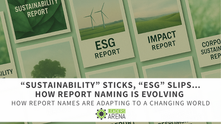ESG communication under the new EU corporate reporting rules (CSRD)
- Editorial Team

- Oct 26, 2021
- 4 min read
With the development of the Corporate Sustainability Reporting Directive (CSRD) standards well underway, here’s what companies around the globe need to know and how to best prepare.

The EU is in the process of updating its corporate sustainability reporting requirements for companies – whether listed or not – to make the standards more vigorous and meaningful for a broader group of stakeholders [1]. The planned transition from the Non-Financial Reporting Directive (NFRD) to the Corporate Sustainability Reporting Directive (CSRD) will include a new ESG reporting standard, aiming to be consistent with the investor-focused Sustainable Financial Disclosure Regulation (SFDR) and new “green” industry classifications introduced by the EU Sustainable Finance Taxonomy (EU Taxonomy).
To best prepare, companies can take proactive steps now including:
A. Understand the EU sustainable finance package - From January 2022, investors will begin to report investee data using already released SFDR indicators, these indicators can be used as a guide to gain an understanding of what disclosures the CSRD will demand. Additionally, companies can leverage the EU Taxonomy environmental objectives to identify sustainable priorities.
B. Align with Paris’ 1.5 degree C goal and TCFD - Aligning the governance of climate risks and opportunities with the Task Force on Climate-related Financial Disclosure (TCFD), as the TCFD will be an important pillar of the new regulation.
C. Adopt a double materiality approach - Assessing issues that are relevant to the company using a “double materiality” approach by considering material issues that affect the business as well as how the business impacts the environment and society.
The NFRD was to some extent considered unfit for purpose, so what makes the CSRD different?
The principles-based approach of the NFRD failed to establish comparable sustainability data for investors. The CSRD has an opportunity to create a level playing field by broadening the scope of application beyond large listed EU companies to many Small and Mid-sized Enterprises (SMEs) whether listed or not, and EU subsidiaries of non-EU companies. By introducing mandatory reporting standards, the new framework could have a global reach similar to the General Data Protection Regulation (GDPR), introduced in 2018.
The CSRD will be more forward-looking by setting the expectation for companies to report on their sustainability strategy and targets. Disclosures under the new regime will also be subject to a third-party Limited Assurance audit, whereas the NFRD had no assurance requirements.
Figure 1: A non-exhaustive comparison between existing NFRD and the proposed CSRD rules.

How can companies start to prepare?
A. Understand the EU sustainable finance package - The new Directive has been developed to compliment the pre-existing regulations and guidance including the EU Taxonomy, which was specifically designed to prevent potential greenwashing by organizations and meet European Green Deal objectives. The EU Taxonomy aims to help market participants identify sustainable activities through six key environmental objectives:
1. Climate change mitigation
2. Climate change adaptation
3. Sustainable use and protection of water and marine resources
4. Transition to a circular economy
5. Pollution prevention and control
6. Protection and restoration of biodiversity and ecosystems.
Similarly, it reinforces the SFDR, which came into effect on March 10, 2021 requiring asset managers to report on which of the three categories their funds fall into: Article 6 (no sustainability integration), Article 8 (promote environmental and social elements) or Article 9 (investments that target sustainable products). Until the CSRD is finalized, companies can refer to the requirements of the SFDR reporting metrics as a guide to start adapting reporting for upcoming changes. Examples include, greenhouse gas emissions, biodiversity, board gender diversity, unadjusted gender pay gap, and anti-corruption and anti-bribery.
B. Align with Paris’ 1.5 degree C goal and TCFD - To address climate change mitigation and adaption, the CSRD will explicitly incorporate the recommendations of the TCFD, and therefore companies can leverage this framework to get ahead of expected CSRD mandatory requirements through using resources such as the TCFD’s guidance on metrics and targets. Similarly, setting Net-Zero goals are increasingly expected to play a key role in achieving the Paris Agreement’s 1.5 degree C climate warming scenario
C. Adopt a double materiality approach - A key component of the new CSRD disclosures will see companies needing to adapt their messages and analysis to both investors and other key stakeholders to ensure they encompass both how sustainability issues impact the company as well as those impacts caused by the company on the environment and society . This exercise may be challenging as companies are expected to consider their entire value chain. To illustrate this point, under a double materiality approach a company’s impact on the world around it would be considered just as important as discussing the financial implications of sustainability issues to the company itself.
Conclusion
The CSRD will further increase the sustainability reporting requirements of companies operating in Europe, potentially setting a new global standard for sustainability reporting. While the exact reporting standard is yet to be finalized, companies can stay ahead of these changes by seeking insights from the draft CSRD requirements, the EU Taxonomy and the SFDR to start planning and adapting disclosures. Adopting a double materiality approach will also help companies ensure their sustainability story meets investors and other stakeholders expectations in line with the new CSRD framework.
References





















